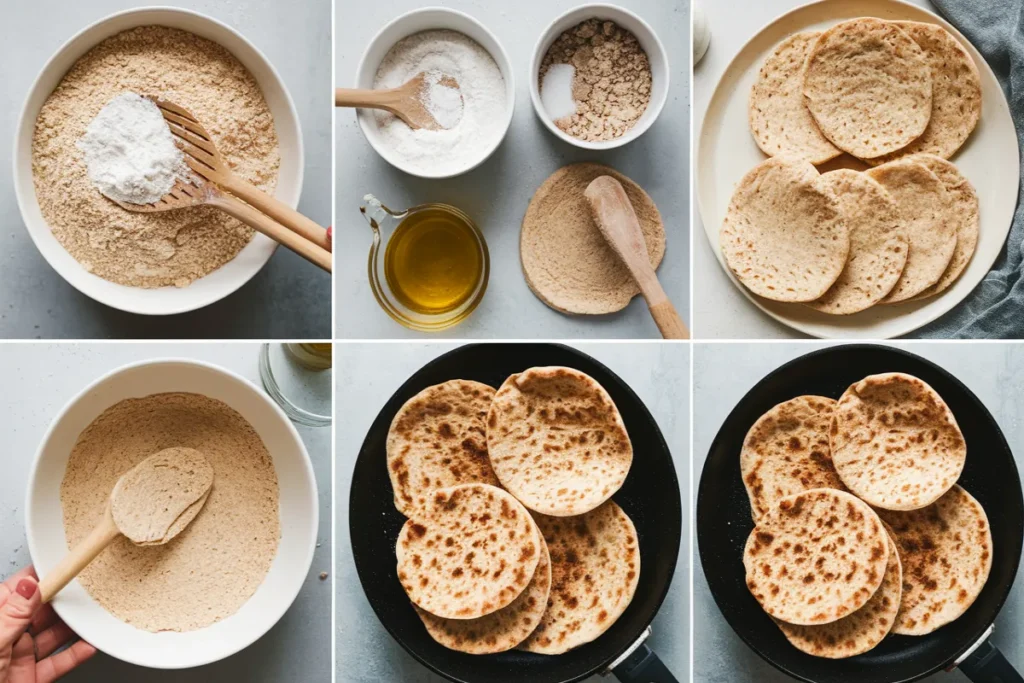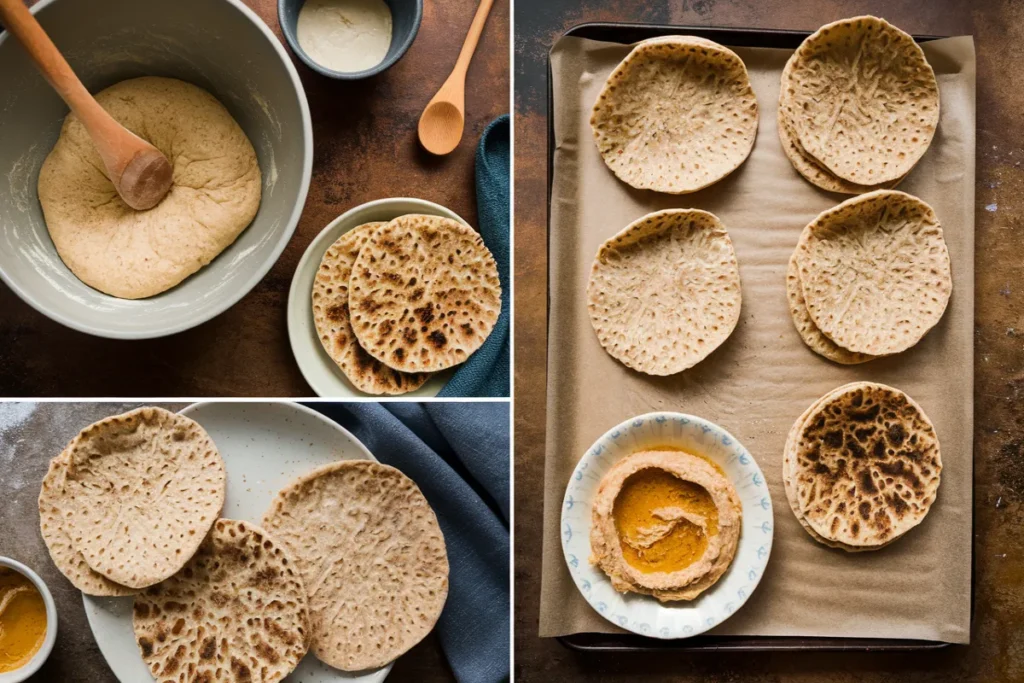If you’re following a gluten-free diet and are missing your favorite pita bread, you’re in luck! Pita is an iconic bread in Middle Eastern and Mediterranean cuisine, but traditional recipes use wheat flour, which contains gluten. By following this easy recipe, you can make soft, tender, and fluffy gluten-free pita at home, free of preservatives and with complete control over the ingredients. Whether you’re using them for sandwiches, dipping, or even making pita chips, these gluten-free pitas will be a game-changer.
In this article, we’ll cover everything you need to know about making your own gluten-free pita bread. We’ll explain why homemade pita is superior to store-bought options, the ingredients you’ll need, step-by-step instructions, and how to serve, store, and reheat your pita for maximum freshness.
Why Make Gluten-Free Pita Bread at Home?
There are numerous reasons to make your own gluten-free pita at home. Not only is it more economical, but it also allows you to customize the ingredients to suit your dietary needs and preferences. Store-bought gluten-free bread products often contain preservatives, have a denser texture, or may lack the authentic puff and softness that makes pita so unique.
Homemade pita can be made quickly and easily, and the results are worth the effort. With this recipe, you can make pitas in under 30 minutes, no yeast required! Plus, there’s something incredibly satisfying about creating your own gluten-free bread from scratch.
Benefits of Homemade Gluten-Free Pita:
- Healthier: You can control the ingredients, avoiding preservatives or unnecessary additives found in store-bought varieties.
- Freshness: Nothing beats the taste and texture of freshly made pita bread.
- Cost-Effective: Making gluten-free pita at home is much cheaper than buying pre-packaged gluten-free bread.
- Customizable: You can modify the recipe to fit your dietary needs, whether you’re dairy-free, egg-free, or vegan.
For other delicious homemade gluten-free bread options, you can try a gluten-free sourdough bread recipe, which pairs wonderfully with dips and spreads, just like this pita!
Essential Ingredients for Gluten-Free Pita Bread

Creating the perfect gluten-free pita starts with the right ingredients. Here’s a breakdown of what you’ll need:
1. Gluten-Free Flour Blend
A high-quality gluten-free flour blend is crucial for achieving the right texture in your pita. I recommend using a blend like Better Batter, which is a well-balanced mix of brown rice flour, potato starch, and other ingredients that help mimic the structure of wheat flour. This flour blend provides stability and elasticity, which are essential for the pita to puff up during baking.
2. Expandex Modified Tapioca Starch
This ingredient is a chemically modified tapioca starch that improves the texture and elasticity of gluten-free dough. It makes the dough easier to handle and helps the pita rise better in the oven. If you don’t have Expandex, you can substitute it with more gluten-free flour, but note that the pita may not puff as much, and the texture might differ.
3. Baking Powder
Since this is a yeast-free gluten-free pita recipe, baking powder acts as the leavening agent. It helps the pita rise and develop those iconic pockets. Make sure your baking powder is fresh; otherwise, your pita might turn out dense and flat.
4. Eggs
Eggs provide structure and help the pita puff up in the oven. This recipe calls for one whole egg and an extra egg white to give the dough the necessary strength and flexibility. If you’re looking for an egg-free version, you can substitute the egg with a chia egg or aquafaba (the liquid from a can of chickpeas).
5. Milk
Milk adds moisture and richness to the dough. You can use any milk you prefer, but for a dairy-free version, almond milk works well and adds a subtle flavor without overpowering the other ingredients.
6. Salt and Oil
Salt is essential for flavor, while oil adds a little richness to the dough, making it tender. A neutral oil like vegetable or canola oil works best.
For more tips on using alternative flours and substitutions in gluten-free recipes, take a look at this Guide to Gluten-Free Flours.
Step-by-Step Guide to Making Gluten-Free Pita

Now that you have all your ingredients ready, let’s dive into the recipe itself. The process is straightforward, and with a few key steps, you’ll have delicious homemade gluten-free pita in no time.
Preparation Steps
- Preheat Your Oven
Preheat your oven to 400°F (200°C). If you have a pizza stone, place it in the oven to preheat. A pizza stone will help the pita puff up and brown nicely. If you don’t have a pizza stone, an overturned baking sheet works just fine. - Mix the Dough
In a large mixing bowl, combine your gluten-free flour blend, Expandex (or extra gluten-free flour if you’re not using Expandex), baking powder, and salt. Mix well to ensure the dry ingredients are evenly distributed.Next, add the oil, eggs, and milk to the dry mixture. Use a stand mixer with a paddle attachment or a food processor to blend the dough until it comes together into a thick, tacky consistency. The dough should pull away from the sides of the bowl, but still be soft and slightly sticky to the touch. - Shape the Dough
Transfer the dough to a lightly floured surface and sprinkle a little more flour on top. Divide the dough into 8 equal portions. Roll each portion into a ball and flatten it into a round disk about 1/4 inch thick. It’s important to keep the dough evenly thin to ensure it puffs properly during baking. - Bake the Pitas
Place the flattened disks of dough onto a parchment-lined baking sheet or your preheated pizza stone. Bake for 2 minutes, then carefully flip the pitas and bake for another 2 minutes on the other side. Keep an eye on them as they bake – the pitas should puff up and turn a pale golden color. - Cool and Serve
Once the pitas are done baking, remove them from the oven and allow them to cool for a few minutes before slicing them open to reveal the pocket inside. Serve warm or at room temperature, depending on your preference.
For those looking for a more indulgent gluten-free meal, consider pairing these pitas with this gluten-free lasagna recipe for a perfect gluten-free Italian feast.
How to Serve Gluten-Free Pita Bread
One of the best things about gluten-free pita is its versatility. You can use it in a variety of dishes, from sandwiches to snacks. Here are a few ideas to get you started:
- Sandwiches: Stuff your pita with gluten-free falafel, grilled chicken, or lamb, along with fresh veggies and hummus for a delicious Mediterranean-style meal.
- Pita Chips: If you have leftover pitas, slice them into triangles, brush them with olive oil, sprinkle with salt, and bake them at 400°F for 7-10 minutes. These make crispy, crunchy pita chips perfect for dipping in hummus, guacamole, or tzatziki.
- Flatbread Pizza: Use the pita as a base for a quick and easy gluten-free pizza. Add tomato sauce, cheese, and your favorite toppings, and bake until the cheese is melted and bubbly.
How to Store and Reheat gluten free pita recipe
To get the most out of your homemade gluten-free pita, follow these storage tips to keep them fresh:
- Short-Term Storage: Store any leftover pita in a sealed container at room temperature for up to 2 days. Make sure they are completely cooled before sealing them to avoid condensation, which can make the pita soggy.
- Freezing: For longer storage, you can freeze your pita. Once cooled, place the pitas in a freezer-safe bag or container, separating each one with parchment paper to prevent sticking. When you’re ready to use them, thaw the pitas at room temperature or warm them up directly from the freezer.
- Reheating: To reheat your pita, you can either microwave them wrapped in a damp paper towel for 20-30 seconds or heat them in a hot skillet for a few minutes on each side. This will help restore the softness and warmth of the bread.
For more hearty and satisfying gluten-free meals, don’t forget to try this gluten-free mac and cheese recipe – it’s a crowd-pleaser for both kids and adults!
FAQs:
1. What is gluten-free pita bread?
Gluten-free pita is a flatbread made using a combination of gluten-free flours and other ingredients that mimic the texture of traditional wheat pita. It’s light, soft, and often forms a pocket that can be used for sandwiches.
2. Why won’t my pita puff up?
If your pita doesn’t puff up, it could be due to several reasons: the dough might be too thick, the oven may not be hot enough, or the dough wasn’t rolled out evenly. Make sure your oven is properly preheated, and roll the dough to an even thickness.
3. Can I make this recipe without eggs or dairy?
Yes, you can substitute the eggs with chia eggs or aquafaba (the liquid from canned chickpeas). For dairy-free pitas, replace the milk with almond milk, soy milk, or another dairy-free alternative.
4. How is pita different from naan?
While both are flatbreads, naan is typically softer, richer, and made with yogurt. Pita bread, on the other hand, is thinner and forms a pocket when baked, making it ideal for stuffing with various fillings.
5. Can I use a cast-iron skillet instead of an oven?
Although a skillet can be used to make flatbreads, it’s not recommended for this recipe. The high, consistent heat of the oven is necessary for the pita to puff properly.
Nutritional Information (Per Pita)
- Calories: 140 kcal
- Carbohydrates: 26g
- Protein: 2g
- Fat: 2g
- Fiber: 1g
- Sodium: 408mg
Final Thoughts
This homemade gluten-free pita bread recipe is easy, versatile, and delicious. It’s the perfect solution for those who miss the taste and texture of traditional pita bread but need a gluten-free option. Plus, the ability to modify the recipe for dairy-free, egg-free, or vegan diets makes it suitable for a wide range of dietary preferences.
So, gather your ingredients and start baking! Whether you use your pita for sandwiches, snacks, or pizza, you’ll be amazed at how fresh, soft, and flavorful homemade gluten-free pita can be.

